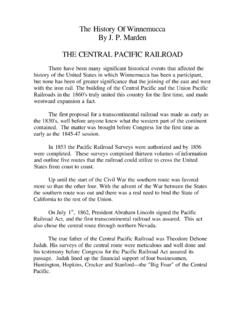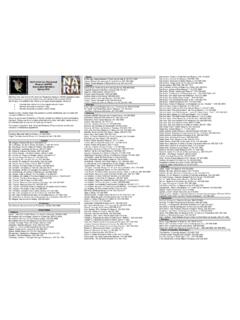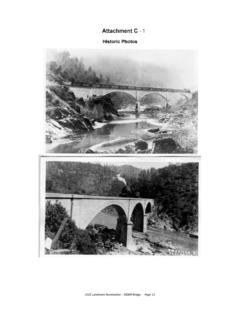Transcription of A A. H ,A - First Transcontinental Railroad - Central ...
1 ALFREDA. HART, ARTISTA lfred A. Hart: Central Pacific Trestle at Newcastle, 1865A rare example of Hart producing a single lens image of the Central Pacific Railroad , probably using his stereo camera modified for panoramic work as shown on thefirst frontispiece. The First car in this view is an inspection/excursion type and the second is an early passenger car borrowed from the recently-purchasedSacramento Valley Railroad . This mounted print, published by Whitney and Paradise from a Hart negative was probably taken in mid-1865. See also Appendix A, for a view of this same trestle under construction. Highway 80 now passes under the center of its modern steel HART, ARTISTBYMEAD B. KIBBEYE dited by Peter E. Palmquist_____THECALIFORNIASTATELIBRARYF OUNDATIONSACRAMENTO, CALIFORNIAC opyright 1995 by california State Library FoundationAll rights reserved. No part of this book may be reproduced inany form without written permission from the 0-929722-85-XPrinted in the United states of AmericaCentral Pacific Railroad Photographic History MuseumProperty of 2006 - Use by permission constitutes acceptance of the User author gives particular thanks to Peter Palmquist and JamesHolliday for their continuous advice, suggestions, and enthusiasticsupport regarding photographic history, california history and thegeneral layout of this are also due to Gary Kurutz, curator of special collections atthe california State Library; Jennifer Watts, associate curator ofphotographs at The Huntington Library, for her numerous letters andassistance in identifying persons in the Hart photographs; TonyTroncale, photography collection, New York Public Library; KathrynTotten, Special Collections,University of Nevada Library; Maja Keech, Prints and Photographsdivision, Library of Congress.
2 KD Kurutz, curator of education, CrockerArt Museum; Walter Gray, director, and Ellen Halteman, librarian, california State Railroad Museum for providing information on earlyCalifornia Railroad construction; James Henley, manager, SacramentoArchives and Museum Collection Center for information onSacramento history and access to the extensive photographiccollection at the thanks to Pauline Grenbeaux Spear who did so much earlyresearch on the life of Alfred Hart and who was the First to plan ahistory of his life. To Glen Willumson who completed Pauline's workand shared much of his research on Hart's Railroad years; to BenjaminBiaggini, former president of the Southern Pacific Railroad whogenerously provided my First Hart views (on glass lantern slides) andmany facts on the early history of the Railroad ; to Jeneane Crawfordwho worked tirelessly with me in taking, developing and printing thehundreds of photographs appearing here, as well as taking field notesand identifying locations on numerous trips along the CPRR Swackhamer permitted the photographing of many of his rareHart stereographs appearing in Appendix A, and later proofread partsof the text and provided many of the correct Railroad terms my wife, Nancy, for her untiring assistance in checking wording and grammar, for thelong hours spent at her computer, for providing help on innumerable photographic excursions,and the inspiration to continue when the whole effort just seemed too Alfred A.
3 Hart who, although he died fourteen years before I was born, I think of as myrespected friend.(Fig. 1.) Alfred A. Hart (1816-1908). While not the First to take pictures in the state, he was born years before the other great early california photographers. Born inNorwich, Connecticut and died in Alameda california . (Photo from private collection.)VTABLEOFCONTENTSE ditor's ForewordIXAuthor's PrefaceXIIntroduction and Brief History of the Constructionof the Central Pacific Railroad15 Starting The Railroad18 Judah's Death at 3722 CPRR Tunneling Methods25 Nitroglycerin Adventures28 Building the World's Longest Barn33 Racing to Utah35 Crocker's Bet to Lay Ten Miles in One Day36A Day of National Rejoicing39 The Problem of Local Time43 Photographing at Promontory44 Notes on Railroad books and appendixes45 Alfred Hart: Photographer, Author and Publisher51 Dating Hart's RR Construction Stereos54 Dating Stereos with Tax Stamps60 Dates the CPRR reached various points62 VThe Fate of Hart's CPRR Negatives69 Hart's years after 186973 Hart's Photographic and Production Methods79 Methods in the Field79 Light Sensitive Materials80 The Wet Collodion Process81 Necessary Ingrediants82 Preparing The Plates for Exposure84 Developing and Fixing the Negative85 Hart's Camera and Equipment89 Shutters95 Stereograph Production96 Making Stereo Prints96 Sensitizing the Paper andPrinting the Negative99 Masking100 Toning, and Fixing the Prints102 Transposing103 Title Strips104 Viewing Stereographs105 Looking for the Photographer109 Hart's Non- Railroad Photographs111 Appendixes.
4 A Reproductions of Hart's CPRR Stereo Views113B Numerical List of Hart's CPRR Stereo Views153C Geographical List of Hart's CPRR Stereos167D Public Sources of Hart's CPRR Stereo Views177E Glenn Willumson's Article on Hart187F Transposing and some Stereo-Camera Details203G Replicas of somePages of Hart's Travel Book213 Reading List and Short Bibliography231 Index233 List of Illustrations238(Fig. 2) Central Pacific track workers on the Utah desert. From a stereograph published by E. & H. T. Anthony & Co., New 'S FOREWORDMead Kibbey has been fascinated with the photographs of AlfredA. Hart for at least two decades. He has seldom, if ever, passedup an opportunity to champion Hart as an artist whose life andwork should be better known today. Happily for us, thisobsession has culminated in this remarkable, and highlypersonalized tribute to the man who documented theconstruction of the Central Pacific Railroad during the Railroad Photographs of Alfred , Artistcontains a great deal about railroading, this isfar from a typical "train" book.
5 Instead the author has chosen tofocus on the events and circumstances of railroading that areVoften over-looked or only briefly discussed. Among these arethe vicissitudes of tunneling--with both nitroglycerin and black-powder techniques--in the brutally dense granite of the ruggedCalifornia mountains. He has also addressed the question ofhow the workers were able to keep tunnels on a perfectlystraight course while working from both sides of a ,The Railroad Photographs of Alfred , Artistis not just a "photographer's monograph."Rather it stands as an excellent primer on the general practicesand problems attendant to wet-plate photography. Especiallyinteresting is Mead's discourse on the ins-and-outs ofcommercial stereography in the American West during study Hart's photography has been to concentrate on thenumerous minute details to be gleaned from a wide variety ofdiverse and scattered evidence. Mead, for example, hassuccessfully collected nearly every known photograph evertaken by Hart of the Central Pacific Railroad .
6 Moreover, he hasmade a special point to visit most of the sites photographed byHart, and has placed his own tripod in the precise same spot asHart's, some onehundred thirty years later. (Many of these locations wereamazingly difficult to reach today and must have been far harderduring the time of wet-collodion photography.)In order to more fully understand Hart's stereography, Meadexperimented with, and produced, actual stereoscopic negativeswith a camera dating from Hart's own era. Through suchpersonal investigation, he has come to intimately understand the"how-to" of different focal length lenses in field photography. Hequickly discovered just how hard it is to adjust an 1860s-styletripod to the rough mountain terrain and jumbles of brokengranite that were still present from the original CPRR has meticulously traced each step of commercialstereograph production, ranging from optical spacing of theprints to labelling the finished card, Driven by his near-obsessive need to understand the process Mead evenmanufactured his own salted has been particularly conscientious in his attempt to dateeach photograph, to provide insight into why they were taken,and wherever possible to placehimself"on the scene.
7 "(Compare, for example, Fig. 39 showing Hart's shadow taken inthe 1860s and Fig. 78 of the author's shadow taken inSeptember 1994.)Bottom line? History, biography, great photographs, and sevensuper appendices (including acatalogue raisonneof everyknown Hart CPRR stereograph).. Anyone who has everwondered about the exact origins of the 364 stereographs whichAlfred A. Hart took to document the construction of the CentralPacific Railroad will find this book an indispensable E. , california , June 10, 1995 VAUTHOR'S PREFACEIn 1962, to illustrate a talk on the centennial of the start of thePacific Railroad at Sacramento, I obtained a set of old glasslantern slides from a friend at the Southern Pacific Railroad . Mytalk received a modest reception, but members of the audiencekept coming up to the podium with the identical question,"Where did yougetthose incredible pictures?." Clearly thephotographer had reached across nearly a century with apowerful proof of the old adage "A picture is worth a thousandwords," at least my was not until thirteen years later, while beginning to collectnineteenth-century photographs, that I gradually realized thosegreat pictures, and many more, had been taken by Alfred A.
8 Hart(1816-1908) of Sacramento, during the construction of theCentral Pacific Railroad from 1864 to 1869. I eventually learnedthat he had published 364 numbered titles of the entire project(plus many variations), that these images had been copied andrepublished foryears, that they had sometimes been claimed by otherphotographers as their own works, and that since 1870 no singlecollection has held all 364 of his titles. Although some finearticles about Hart had appeared in magazines,I could not find a single book about him or his the exact sites from which Hart took many of his viewsin california was just difficult enough to make it fun, and itbecame a sort of hobby with me. In the process I came to deeplyrespect Hart, and to feel that although a century apart, he and Ihad photographed a work of giants. For nearly a century, theSierra Nevada Mountains had been considered an impenetrablebarrier by the Spanish settlers of california , and the NativeAmericans only ventured into those forbidding heights during thefew summer months.
9 In the winter wind-gusts at the summitreach 100 miles per hour and the annual snowfall can in the 1850s, the lands of Northern Californiahave been carefully surveyed into townships and sections by asuccession of government agencies. The earliest surveysstarted with the most valuable and accessable areas; yet soremote were the Sierra summits that even in 1995, entiretownships of 36 square miles are still waiting to be surveyed intosections. Clearly, those who drove the Central Pacific throughthe Sierra, as Herodotus said of the builders of the pyramids"seem a mightier race of men than now inhabit the earth."As the official photographer of the Central Pacific, Hart was theonly one to record scenes during the actual construction of therailroad over the mountains. He was permitted to stop trains andwork crews for the time needed to set up his camera and to findthe best location for his photographs. He was also allowed tohave his small photo-darkroom-wagon hauled to the end-of-trackon a Railroad flat car where he pushed ahead to capture scenesof the early stages of excavation for the road bed.
10 Because hewas on site well before the completion of the famous snowshedsin 1869, and before the tracks were in such heavy use, Hart wasable to take advantage of photographic opportunities notavailable to other photographers of that era. In addition, hisphotographs taken along this route during the actual process ofbuilding trestles, constructing enormous embankments, anddigging tunnels canneverbe the completion of the road to Promontory, Utah, Hart wasfollowed by several famous contemporaries, such as EadweardJ. Muybridge (1830-1904), John James Reilly (1838-1894), andCharles R. Savage (1832-1909).1A few local photographers operating from such places as DutchFlat, Truckee, and Auburn also produced views ofthe Railroad . Each of these photographers published in Hart'sstereo-card format, and a surprising number oftheir images were taken from exactly the same camera locationspreviously selected by they are very difficult to locate today,Hart did produce a few photographs in other formats such as thecarte de visite and 5-by-8 inch formats, plus many half stereos (asingle image) which were used for albums and catalogs.










